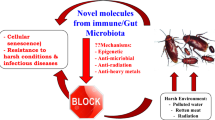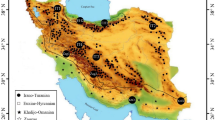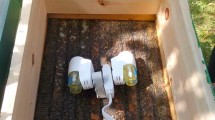Abstract
Raspberry ketone (RK) supplements provided together with sugar and yeast hydrolysate accelerate sexual maturation and increase mating success of Queensland fruit fly (‘Qfly’) males. However, the mechanisms underlying this enhanced mating ability are currently unknown. Volatiles are an important element of Qfly sexual calling and courtship and so changes in volatiles quantity or quality may be involved, and the present study investigated this possibility. Flies were fed a diet of sugar only (S) or yeast hydrolysate mixed with sugar (YH + S) (1:3) that contained 0% RK (control) and 5% RK (treated) for 2 days after emergence. Volatile compounds were extracted from rectal glands when flies were 6, 8, 10, 20, and 30 days old. Males fed on RK exhibited a significant increase in total volatile production in rectal glands compared to RK-unfed males (control). Males fed on RK with YH + S produced significantly higher amount of volatiles than males fed on RK with sugar only. Males fed on YH + S diet produced more volatiles in the presence of RK compared to males fed on YH + S diet only. Two compounds, N-(3-methylbutyl)acetamide and N-(3-methylbutyl)propanamide were dominant in endogenously produced rectal gland volatiles comprising ca. more than 90% of the total amount in both RK-fed and control males. Considering exogenous and endogenous compounds together, unaltered RK was dominant along with these two endogenous compounds in RK-fed males in rectal gland until 30 days of age in both diet groups.




Similar content being viewed by others
Availability of data and material
Authors have right to get access to data and materials.
References
Akter H, Mendez V, Morelli R, Pérez J, Taylor PW (2017) Raspberry ketone supplement promotes early sexual maturation in male Queensland fruit fly, Bactrocera tryoni (Diptera: Tephritidae). Pest Manag Sci 73:1764–1770
Amano T, Nishida R, Kuwahara Y, Fukami H (1999) Pharmacophagous acquisition of clerodendrins by the turnip sawfly (Athalia rosae ruficornis) and their role in the mating behavior. Chemoecology 9:145–150
Bateman MA (1982) Chemical methods for suppression or eradication of fruit fly populations. In: Drew RAI, Hooper GHS, Bateman MA (eds) Economic Fruit flies of the South Pacific region. Queensland Department of Primary Industries, Brisbane, pp 115–128
Bellas TE, Fletcher BS (1979) Identification of the major components in the secretion from the rectal pheromone glands of the Queensland fruit flies Dacus tryoni and Dacus neohumeralis (Diptera: Tephritidae). J Chem Ecol 5:795–803
Beyaert I, Hilker M (2014) Plant odour plumes as mediators of plant–insect interactions. Biol Rev 89:68–81
Boppré M (1984) Redefining “pharmacophagy”. J Chem Ecol 10:1151–1154
Brieze-Stegeman R, Rice MJ, Hooper GHS (1978) Daily periodicity in attraction of male Tephritidae fruit flies to synthetic chemical lures. J Aust Entomol Soc 17:341–346
Canale A, Germinara SG, Carpita A, Benelli G, Bonsignori G, Stefanini C, Raspi A, Rotundo G (2013) Behavioural and electrophysiological responses of the olive fruit fly, Bactrocera oleae (Rossi) (Diptera: Tephritidae), to male- and female-borne sex attractants. Chemoecology 23:155–164
Canale A, Benelli G, Germinara GS, Fusini G, Romano D, Rapalini F, Desneux N, Rotundo G, Raspi A, Carpita A (2015) Behavioural and electrophysiological responses to overlooked female pheromone components in the olive fruit fly, Bactrocera oleae (Diptera: Tephritidae). Chemoecology 25:147–157
Dominiak BC, Ekman JH (2013) The rise and demise of control options for fruit fly in Australia. Crop Protect 51:57–67
Dominiak BC, Westcott AE, Barchia IM (2003) Release of sterile Queensland fruit fly, Bactrocera tryoni (Froggatt) (Diptera: Tephritidae), at Sydney, Australia. Aust J Exp Agric 43:519–528
Dominiak BC, Sundaralingam S, Jiang L, Jessup A, Barchia I (2008) Production levels and life history traits of mass reared Queensland fruit fly Bactrocera tryoni (Froggatt) (Diptera: Tephritidae) during 1999/2002 in Australia. Plant Protect Quart 23:131
Dominiak BC, Clifford CS, Nielsen SG (2009) Queensland fruit fly (Bactrocera tryoni Froggatt) attraction to and chemical analysis of male annihilation blocks using three concentrations of cuelure at Dubbo, New South Wales, Australia. Plant Protect Quart 24:157–160
Dominiak BC, Campbell A, Worsley P, Nicol H (2011) Evaluation of three ground release methods for sterile Queensland fruit fly Bactrocera tryoni (Froggatt)(Diptera: Tephritidae). Crop Protect 30:1541–1545
Epsky ND, Heath RR (1993) Food availability and pheromone production by males of Anastrepha suspensa (Diptera: Tephritidae). Environ Entomol 22:942–947
Fletcher BS (1968) Storage and release of a sex pheromone by the Queensland fruit fly, Dacus tryoni (Diptera: Trypetidae). Nature 219:631–632
Fletcher BS (1969) The structure and function of the sex pheromone glands of the male Queensland fruit fly, Dacus tryoni. J Insect Physiol 15:1309–1322
Fletcher BS, Giannakakis A (1973) Factors limiting the response of females of the Queensland fruit fly, Dacus tryoni, to the sex pheromone of the male. J Insect Physiol 19:1147–1155
Fletcher MT, Kitching W (1995) Chemistry of fruit flies. Chem Rev 95:789–828
Giannakakis A, Fletcher BS (1978) An improved bioassays technique for the sex pheromone of male Dacus tryoni (Diptera: Tephritidae). Can Entomol 110:125–129
Hee AKW, Tan KH (1998) Attraction of female and male Bactrocera papayae to conspecific males fed with methyl eugenol and attraction of females to male sex pheromone components. J Chem Ecol 24:753–764
Hee AKW, Tan KH (2004) Male sex pheromonal components derived from methyl eugenol in the hemolymph of the fruit fly Bactrocera papayae. J Chem Ecol 30:2127–2138
Hee AKW, Tan KH (2005) Bioactive fractions containing methyl eugenol-derived sex pheromonal components in haemolymph of the male fruit fly Bactrocera dorsalis (Diptera: Tephritidae). Bull Entomol Res 95:615–620
Hee AKW, Tan KH (2006) Transport of methyl eugenol-derived sex pheromonal components in the male fruit fly, Bactrocera dorsalis. Comp Biochem Physiol Part C 143:422–428
Hirvi T, Honkanen E (1984) The aroma of the fruit of sea buckthorn, Hippophae rhamnoides L. Z Lebensm-Unters Forsch 179:387–388
Hirvi T, Honkanen E, Pyysalo T (1981) The aroma of cranberries. Z Lebensm-Unters Forsch 172:365–367
Jessup A, Dominiak B, Woods B, De Lima C, Tomkins A, Smallridge C (2007) Area-wide management of fruit flies in Australia. In: Vreysen MJB, Robinson AS, Hendrichs J (eds) Area-wide control of insect pests. Springer, Dordrecht, pp 685–697
Katte T, Tan KH, Su ZH, Ono H, Nishida R (2020) Floral fragrances in two closely related fruit fly orchids, Bulbophyllum hortorum and B. macranthoides (Orchidaceae): assortments of phenylbutanoids to attract tephritid fruit fly males. Appl Entomol Zool 55:33–64
Khoo CCH, Tan KH (2000) Attraction of both sexes of melon fly, Bactrocera cucurbitae to conspecific males—a comparison after pharmacophagy of cue-lure and a new attractant–zingerone. Ent Exp Appl 97:317–320
Krasnoff SB, Dussourd DE (1989) Dihydropyrrolizine attractants for arctiid moths that visit plants containing pyrolizidine alkaloids. J Chem Ecol 15:47–60
Kumaran N, Hayes RA, Clarke AR (2014) Cuelure but not zingerone make the sex pheromone of male Bactrocera tryoni (Tephritidae: Diptera) more attractive to females. J Insect Physiol 68:36–43
Landolt PJ, Phillips TW (1997) Host plant influences on sex pheromone behavior of phytophagous insects. Ann Rev Entomol 2:371–391
Landolt PJ, Sivinski J (1992) Effects of time of day, adult food, and host fruit on incidence of calling by male Caribbean fruit flies (Diptera: Tephritidae). Environ Entomol 21:382–387
Liedo P, Orozco D, Cruz- López L, Quintero JL, Becerra-Pérez C, Hernández MDR, Oropeza A, Toledo J (2013) Effect of post-teneral diets on the performance of sterile Anastrepha ludens and Anastrepha obliqua fruit flies. J Appl Entomol 137:49–60
Liu P, Ding H, Christensen BM, Li J (2012) Cysteine sulfinic acid decarboxylase activity of Aedes aegypti aspartate 1-decarboxylase: the structural basis of its substrate selectivity. Insect Biochem Mol Biol 42:396–403
Lucas-Barbosa D, Joop JA, van Dicke LM (2011) The effects of herbivore-induced plant volatiles on interactions between plants and flower-visiting insects. Phytochemistry 72:1647–1654
Marco JA, Barbera O, Rodriguez S, Domingo C, Adell J (1988) Flavonoids and other phenolics from Artemisia hispanica. Phytochemistry 27:3155–3159
Meats A, Hartland C (1999) Upwind anemotaxis in response to cue-lure by the Queensland fruit fly, Bactrocera tryoni. Physiol Entomol 24:90–97
Meats A, Clift AD, Perepelicia N (2002) Performance of permanent and supplementary traps for Mediterranean and Queensland fruit flies in South Australia 1975–2001: comparison of male lure and food lure traps. Gen Appl Entomol 31:53–58
Meats AW, Duthie R, Clift AD, Dominiak BC (2003) Trials on variants of the Sterile Insect Technique (SIT) for suppression of populations of the Queensland fruit fly in small towns neighbouring a quarantine (exclusion) zone. Aust J Exp Agric 43:389–395
Meats A, Holmes H, Kelly G (2004) Laboratory adaptation of Bactrocera tryoni (Diptera: Tephritidae) decreases mating age and increases protein consumption and number of eggs produced per milligram of protein. Bull Entomol Res 94:517–524
Metcalf RL (1990) Chemical ecology of Dacinae fruit flies (Diptera: Tephritidae). Ann Entomol Soc Am 83:1017–1030
Metcalf RL, Metcalf ER (1992) Plant kairomones in insect ecology and control. Chapman and Hall, New York
Monro J, Osborn AW (1967) The use of sterile males to control populations of Queensland fruit fly Dacus tryoni (Frogg)(Diptera: Tephritidae). I. Methods of mass rearing, transporting, irradating and releasing sterile flies. Aust J Zool 15:461–473
Nation JL (1989) The role of pheromones in the mating system of Anastrepha fruit flies. In: Robinson AS, Hooper G (eds) World crop pests: fruit flies, their biology, natural enemies and control. Elsevier, Amsterdam, pp 189–205
Nishida R, Fukami H (1990) Sequestration of distasteful compounds by some pharmacophagous insects. J Chem Ecol 16:151–164
Nishida R, Tan KH, Serit M, Lajis NH, Sukari AM, Takahashi S, Fukami H (1988) Accumulation of phenylpropanoids in the rectal glands of males of the Oriental fruit fly, Dacus dorsalis. Experientia 44:534–536
Nishida R, Tan KH, Takahashi S, Fukami H (1990) Volatile components of male rectal glands of the Melon fly, Dacus cucurbitae Coquillette (Diptera:Tephritidae). Appl Ent Zool 25(1):105–112
Nishida R, Iwahashi O, Tan KH (1993) Accumulation of Dendrobium superbum (Orchidaceae) fragrance in the rectal glands by males of the melon fly, Dacus cucurbitae. J Chem Ecol 19:713–722
O’Flynn BG, Suarez G, Hawley AJ, Merkler DJ (2018) Insect arylalkylamine N-acyltransferases: mechanism and role in fatty acid amide biosynthesis. Front Mol Biosci 5:66
Osborne R, Meats A, Frommer M, Sved JA, Drew RAI, Robson MK (1997) Australian distribution of 17 species of fruit flies (Diptera; Tephritidae) caught in cue lure traps in February 1994. Aust J Entomol 36:45–50
Park SJ, De Faveri SG, Cheesman J, Hanssen BL, Cameron DNS, Jamie IM, Taylor PW (2020) Zingerone in the flower of Passiflora maliformis attracts an Australian fruit fly, Bactrocera jarvisi (Tryon). Molecules 25:2877
Pérez J, Park SJ, Taylor PW (2018) Domestication modifies the volatile emissions produced by male Queensland fruit flies during sexual advertisement. Sci Rep 8:16503. https://doi.org/10.1038/s41598-018-34569-3
Pike N, Meats A (2003) Tendency for upwind movement in the sibling fruit fly species, Bactrocera tryoni and B. neohumeralis and their hybrids (Diptera: Tephritidae): influence of time of day, sex and airborne pheromone. Bull Entomol Res 93:173–178
Raina AK, Kingan TG, Mattoo AK (1992) Chemical signals from host plant and sexual behavior in a moth. Science 255:592
Reddy GV, Guerrero A (2004) Interactions of insect pheromones and plant semiochemicals. Trends Plan Sci 9:253–261
Renou M, Guerrero A (2000) Insect parapheromones in olfaction research and semiochemical-based pest control strategies. Ann Rev Entomol 45:605–630
Reynolds OL, Dominiak BC, Orchard BA (2010) Pupal release of the Queensland fruit fly, Bactrocera tryoni (Froggatt) (Diptera: Tephritidae), in the sterile insect technique: seasonal variation in eclosion and flight. Aust J Entomol 49:150–159
Schneider D, Boppré M, Schneider H, Thompson WR, Boriack CJ, Petty RL, Meinwald J (1975) A pheromone precursor and its uptake in male Danaus butterflies. J Comp Physiol 97:245–256
Shelly TE (2000) Effects of raspberry ketone on the mating success of male melon flies (Diptera: Tephritidae). Proc Hawaii Entomol Soc 34:143–147
Shelly TE (2010) Effects of methyl eugenol and raspberry ketone/cue lure on the sexual behavior of Bactrocera species (Diptera: Tephritidae). Appl Entomol Zool 45:349–361
Shelly TE, Dewire ALM (1994) Chemically mediated mating success in male oriental fruit flies (Diptera: Tephritidae). Ann Entomol Soc Am 87:375–382
Shelly TE, Nishida R (2004) Larval and adult feeding on methyl eugenol and the mating success of male oriental fruit flies, Bactrocera dorsalis. Entomol Exp Appl 112:155–158
Shelly TE, Villalobos EM (1995) Cue lure and the mating behavior of male melon flies (Diptera: Tephritidae). Fla Entomol 78:473–482
Shelly TE, Edu J, McInnis D (2010) Pre-Release consumption of methyl eugenol increases the mating competitiveness of sterile males of the oriental fruit fly, Bactrocera dorsalis, in large field enclosures. J Insect Sci 10:8
Tan KH (2000) Sex pheromone components in defense of melon fly, Bactrocera cucurbitae against Asian house gecko, Hemidactylus frenatus. J Chem Ecol 26:697–704
Tan KH, Nishida R (1995) Incorporation of raspberry ketone in the rectal glands of males of the Queensland fruit fly, Bactrocera tryoni Froggatt (Diptera: Tephritidae). Appl Entomol Zool 30:494–497
Tan KH, Nishida R (1996) Sex pheromone and mating competition after methyl eugenol consumption in the Bactrocera dorsalis complex. In: McPheron BA, Steck GJ (eds) Fruit fly pests: a world assessment of their biology and management. St. Lucie Press, Delray Beach, pp 147–153
Tan KH, Nishida R (2000) Mutual reproductive benefits between a wild orchid, Bulbophyllum patens, and Bactrocera fruit flies via a floral synomone. J Chem Ecol 26:533–546
Tan KH, Nishida R (2005) Synomone or kairomone?—Bulbophyllum apertum flower releases raspberry ketone to attract Bactrocera fruit flies. J Chem Ecol 31(3):497–507
Tan KH, Nishida R (2007) Zingerone in the floral synomone of Bulbophyllum baileyi (Orchidaceae) attracts Bactrocera fruit flies during pollination. Biochem Syst Ecol 35:334–341
Tan KH, Tokushima I, Ono H, Nishida R (2011) Comparison of phenylpropanoid volatiles in male rectal pheromone gland after methyl eugenol consumption, and molecular phylogenetic relationship of four global pest fruit fly species: Bactrocera invadens, B. dorsalis, B. correcta and B. zonata. Chemoecology 21:25–33
Tan KH, Nishida R, Jang EB, Shelly TE (2014) Pheromones, male lures, and trapping of tephritid fruit flies. In: Shelly TE, Epsky N, Jang EB, Reyes-Flores J, Vargas RI (eds) Trapping and the detection, control, and regulation of tephritid fruit flies. Springer, Berlin, pp 15–74
Teal PEA, Gomez-Simuta Y, Dueben BD, Holler TC, Olson SR (2007) Improving the efficacy of the sterile insect technique for fruit flies by incorporation of hormone and dietary supplements into adult holding protocols. In: Vreysen MJB, Robinson AS, Hendrichs J (eds) Area-wide control of insect pests: from research to field implementation. Springer, Dordrecht, pp 163–173
Tillman JA, Seybold SJ, Jurenka RA, Blomquist GJ (1999) Insect pheromones—an overview of biosynthesis and endocrine regulation. Insect Biochem Mol Biol 29:481–514
Tychsen PH (1977) Mating behaviour of the Queensland fruit fly, Dacus tryoni (Diptera: Tephritidae) in field cages. J Aust Entomol Soc 16:459–465
Vargas RI, Shelly TE, Leblanc L, Piñero JC (2010) Recent advances in methyl eugenol and cue-lure technologies for fruit fly detection, monitoring, and control in Hawaii. Vitam Horm 83:575–595
Wee SL, Tan KH (2005) Female sexual response to male rectal volatile constituents in the fruit fly, Bactrocera carambolae (Diptera: Tephritidae). Appl Entomol Zool 40:365–372
Wee SL, Tan KH (2007) Temporal accumulation of phenylpropanoids in male fruit flies, Bactrocera dorsalis and B. carambolae (Diptera: Tephritidae) following methyl eugenol consumption. Chemoecology 17:81–85
Wee SL, Tan KH, Nishida R (2007) Pharmacophagy of methyl eugenol by males enhances sexual selection of Bactrocera carambolae. J Chem Ecol 33:1272–1282
Weldon CW (2007) Influence of male aggregation size on female visitation in Bactrocera tryoni (Froggatt) (Diptera: Tephritidae). Aust J Entomol 46:29–34
Acknowledgements
Authors gratefully acknowledge the assistance of Professor Phil Taylor, Macquarie University, Sydney, Australia, who helped with valuable comments during designing the experiment and preparing the manuscript. Authors are also grateful to Associate Professor Suk Ling Wee, Faculty of Science and Technology, Universiti Kebangsaan Malaysia and Dan Ryan, Horticulture Innovation Australia Limited, for helping in preparing this manuscript with valuable comments. Authors are thankful to the staff at New South Wales Department of Primary Industries, especially Solomon Balagawi, who generously provided pupae. This research was conducted as part of the SITplus collaborative fruit fly program. Project Raising Qfly Sterile Insect Technique to World Standard (HG14033) is funded by the Hort Frontiers Fruit Fly Fund, part of the Hort Frontiers strategic partnership initiative developed by Hort Innovation, with co-investment from Macquarie University and contributions from the Australian Government. HA was supported by a Macquarie University Research Excellence Scholarship (MQRES).
Funding
This research was conducted as part of the SITplus collaborative fruit fly program. Project Raising Qfly Sterile Insect Technique to World Standard (HG14033) is funded by the Hort Frontiers Fruit Fly Fund, part of the Hort Frontiers strategic partnership initiative developed by Hort Innovation, with co-investment from Macquarie University and contributions from the Australian Government. HA was supported by a Macquarie University Research Excellence Scholarship (MQRES).
Author information
Authors and Affiliations
Contributions
Humayra Akter planned and designed experiment. All authors conducted research experiment. Humayra Akter wrote the manuscript, Jeanneth Pérez and Soo Jean Park provided inputs to prepare this manuscript. Humayra Akter analyzed data.
Corresponding author
Ethics declarations
Conflict of interest
Not applicable.
Consent for publication
Yes, Chemoecology can publish.
Additional information
Handling Editor: Günther Raspotnig.
Electronic supplementary material
Below is the link to the electronic supplementary material.
Rights and permissions
About this article
Cite this article
Akter, H., Pérez, J. & Park, S.J. Raspberry ketone supplements provided to immature male Queensland fruit fly, Bactrocera tryoni (Froggatt), increase the amount of volatiles in rectal glands. Chemoecology 31, 89–99 (2021). https://doi.org/10.1007/s00049-020-00333-1
Received:
Accepted:
Published:
Issue Date:
DOI: https://doi.org/10.1007/s00049-020-00333-1




